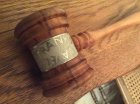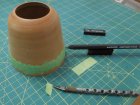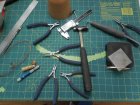I have an idea of how to hold together a thin walled turning such as a large goblet form or a lamp shade. The pieces would have wall thickness from 1/16th" (1.5875 mm) down to 1/32nd" (0.79375 mm) so obviously butterfly's would not work. The idea is to make a strip of veneer cut to an arc that would meet at the circumference of the area being bound and also match the taper. (Think of the bands on barrels) The project in the photo is a goblet form turned from dead red oak that had checks in the outer surfaces but not in the inner green core. The rubber band is to keep the wood between the various checks from opening more due to centrifugal force, however a finished piece would need something more permanent. The area where I expect to put the band is about 5 1/2" diameter with a circumference of 17 1/4" (438.658 mm) and an angle of about 15 degrees. 













